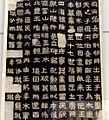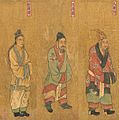Goguryeo facts for kids
Goguryeo was a very old and powerful kingdom in Korea. It was started by a brave leader named Jumong in 37 BC. This kingdom grew to be one of the strongest in East Asia and lasted for many centuries.
The story of how Goguryeo began is quite interesting! Legend says that Jumong was born from an egg and was raised by King Gumwa of East Buyeo. His name, Jumong, actually means someone who is great at archery. Because he was so skilled, another prince, Daeso, became quite jealous. Feeling unsafe, Jumong decided to leave East Buyeo with his three friends. He traveled to a place called Jolbon Buyeo. There, he married Sosuno, who was the princess of that land. Jumong later became king and changed the name of the kingdom to Goguryeo, using his own family name.
Goguryeo's Golden Age
From its very first king, King Dongmyeong, Goguryeo faced many challenges. It was often attacked by powerful neighbors, like the Chinese Han dynasty and the Xianbei people. But Goguryeo was strong and managed to defend itself. By the time of its 11th king, Goguryeo had even taken control of the Liaoong area.
The kingdom truly reached its peak, or "golden age," under its 19th king, King Gwanggaeto the Great. He was one of the most famous kings of Goguryeo. During his rule, the kingdom expanded its land greatly and successfully pushed back all attacks from outside forces. Goguryeo became a very large and powerful empire during this time.
The End of Goguryeo
However, things started to change for Goguryeo later on. When King Youngryou was the 27th king, Goguryeo began to become less independent and more like a smaller state under the powerful Chinese Tang Dynasty. This made a general named Yoen Gaesomoon very angry. He killed King Youngryou, and a new king, Bojang, took the throne.
After Yoen Gaesomoon died, the people of Goguryeo didn't work together as well as they used to. The kingdom became weaker. Eventually, the combined armies of the Tang Dynasty and the Korean kingdom of Silla attacked Goguryeo. In 668 AD, after many centuries of power, Goguryeo was finally defeated and fell.
Images for kids
-
Seated buddhas and bodhisattvas from Wono-ri, Goguryeo.
-
A gilt-bronze crown from Goguryeo believed to have once adorned the head of a bodhisattva image.
-
Detail of a rubbing of the Gwanggaeto Stele (414 AD), one of the few surviving records made by Goguryeo, written in Classical Chinese.
-
Painting of envoys from the Three Kingdoms of Korea to the Tang court: Silla, Baekje, and Goguryeo. Portraits of Periodical Offering, circa 650 AD, Tang dynasty
-
Goguryeo ambassadors during an audience with King Varkhuman of Samarkand. They are identified by the two feathers on top of their head. 648–651 AD, Afrasiab murals, Samarkand.
-
Ssireum depicted on Goguryeo mural
See also
 In Spanish: Goguryeo para niños
In Spanish: Goguryeo para niños















